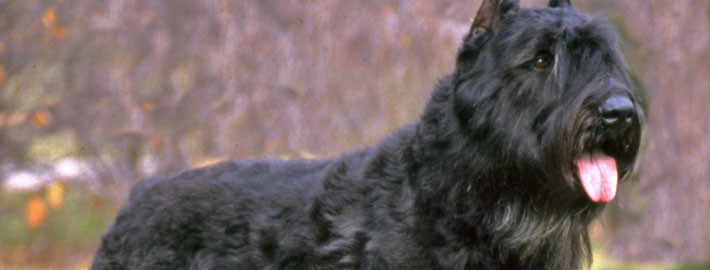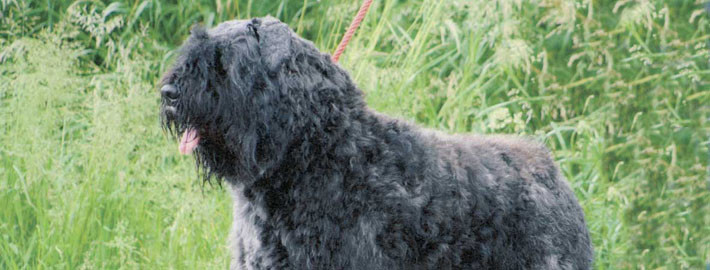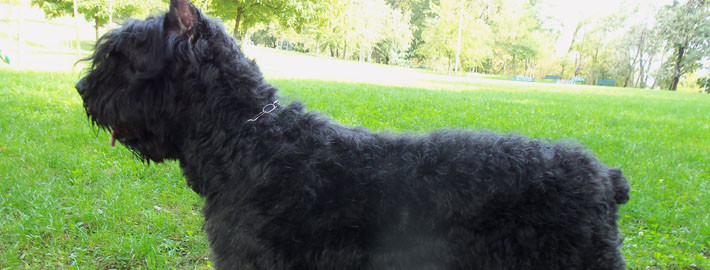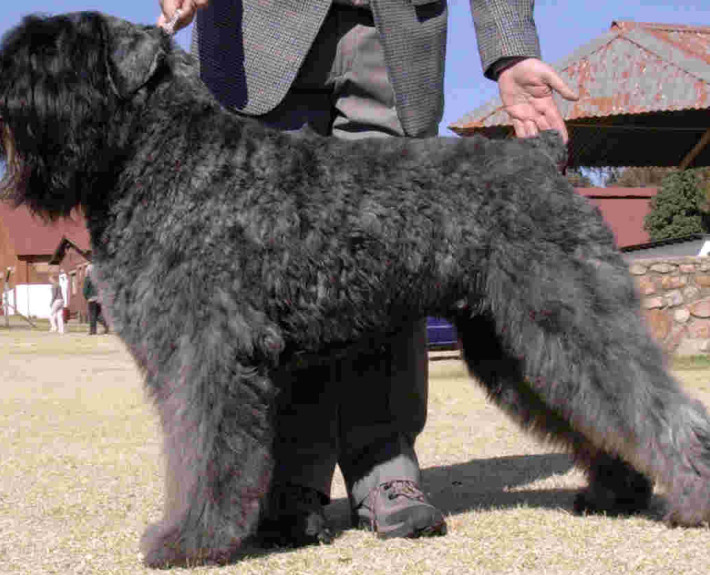What makes the Bouvier des Flandres Unique?
This is a versatile breed able to perform a variety of functions, including cattle herder, draft dog and guard. As such, it combines great strength with agility and endurance. The bouvier is a compact, short-coupled dog, of square proportion and rugged appearance. Its gait is free, bold and proud. Its weatherproof coat is tousled and double, with a fine undercoat and a harsh, dry outer coat. It is trimmed (if necessary) to a length of about 2.5 inches. The head is accentuated by a beard and moustache, which adds to the dog’s bold and alert expression. The bouvier is a steady, stalwart companion that is loyal, devoted, fearless and protective. Given daily exercise, it is calm and well-mannered indoors, but ready for an adventure in the great outdoors. It is independent and confident of its own judgment, yet biddable and willing to please. It can be domineering. It is reserved, even protective, toward strangers and can be aggressive with strange dogs. It is very good with children, although it may nip at heels in play.
Page Contents
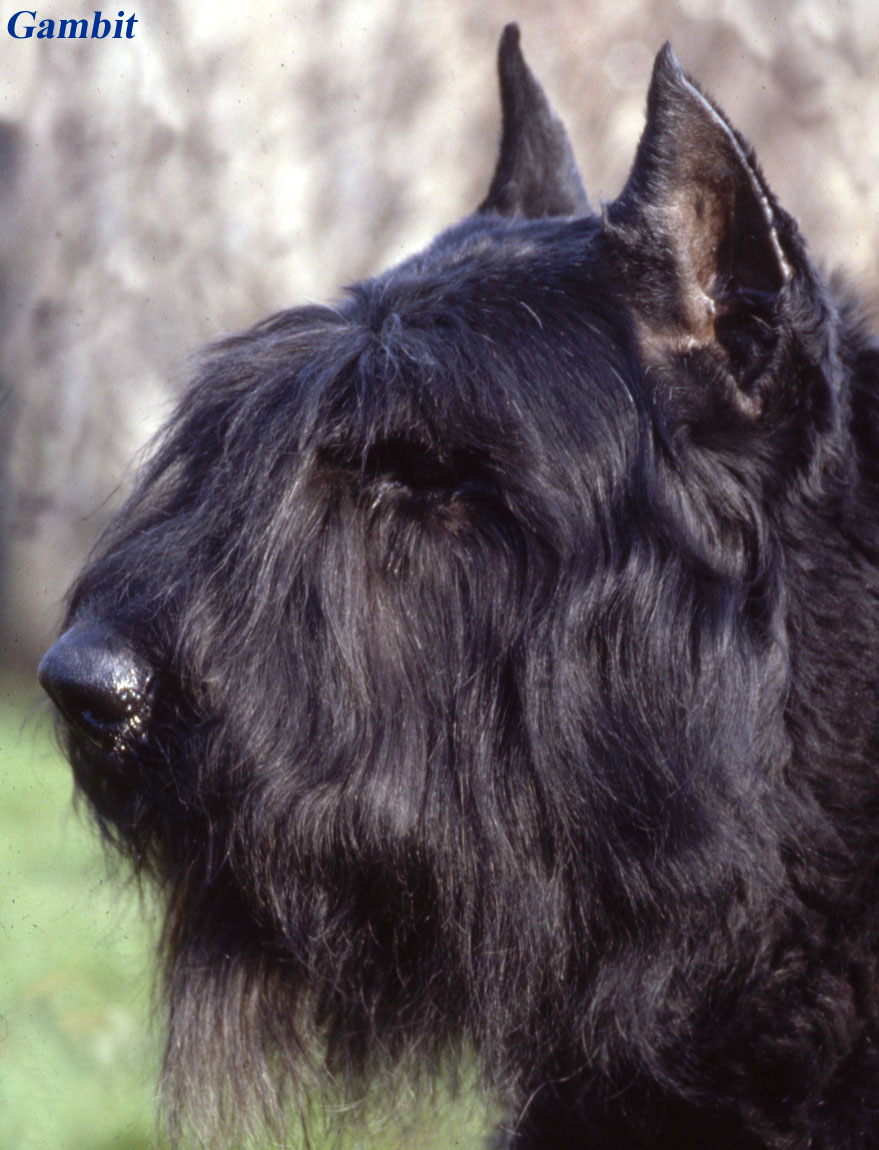
SnapShot
| Size: | Males – 58 to 71 cm (23 to 28 inches) Females – 56 to 69 cm (22 to 27 inches) |
| Weight: | Males – 36 to 54 kg (80 to 120 pounds) Females – 27 to 36 kg (60 to 80 pounds) |
| Origin: | Belgium (Flanders) |
| Life Span: | 10 to 12 years |
| Colour: | Fawn, brindle, black, grey or blonde |
| Litter Size: | 5 to 10 puppies, 8 is being common |
Is the Bouvier des Flandres Right For You?
Bouvier is a compact, short-coupled dog, of square proportion and rugged appearance. Its gait is free, bold and proud. Its weatherproof coat is tousled and double, with a fine undercoat and a harsh, dry outer coat. It is trimmed (if necessary) to a length of about 2.5 inches. The head is accentuated by a beard and moustache, which adds to the dog’s bold and alert expression. The bouvier is a steady, stalwart companion that is loyal, devoted, fearless and protective. Given daily exercise, it is calm and well-mannered indoors, but ready for an adventure in the great outdoors. It is independent and confident of its own judgment, yet biddable and willing to please. It can be domineering. It is reserved, even protective, toward strangers and can be aggressive with strange dogs.
In 5 Words
- Protective
- Gentle
- Loyal
- Familial
- Rational
Characteristics
Learn About the Bouvier des Flandres
Description
The Bouvier is a large, powerful, rugged looking dog. The head is in proportion to the body, giving the dog a square profile. The broad, somewhat short back has a firm level top-line. The head is flat, slightly longer than it is wide. The skull is parallel with the muzzle which is wide between the ears. The muzzle is slightly tapered, broad and strong. The nose is black. The bushy eyebrows make the stop more pronounced than it really is. The teeth meet in a scissors bite. The dark brown eyes are oval in shape with black eye rims. The triangular ears are set high either cropped or left natural. The well muscled back legs are powerful and the front legs are straight. The tail is set high and usually docked. Note, it is illegal to crop or dock a dog’s body parts (tail and ears) in most parts of Europe. Dewclaws are usually removed. The double coat is weather-resistant with rough, harsh outer hairs. The undercoat is fine and soft but dense. The coat is cut so it has a shaggy, thick beard and eyebrows giving the dog a distinctive look. Coat colors come in black, fawn, blonde, salt and pepper, gray, or brindle. Sometimes with a small white star on the chest. Solid black coats are not favored in the show ring, but are accepted and blonde coats are not accepted. Dutch bloodlines are often larger and heavier than Belgians lines.
Short History of the Flanders
The monks at the Ter Duinen monastery in Flanders were among the earliest known breeders of Flanders. The bouviers bred by them are recorded as having been bred from imports such as Irish wolfhounds and Scottish Deerhounds with local farm dogs, until a breed considered to be the predecessor of the modern Bouvier des Flandres was obtained. This became a working dog able to perform tirelessly, herding and guarding cattle and even pulling cargo carts, thanks to its strength and temperament, and to withstand the local weather conditions due to its thick coat.
Historically, the ear cropping and tail docking could have been done for practical reasons, avoiding accidental amputations in the course of work, or to indicate the dog was working stock and not a pet subject to taxation.
Up until the early 20th century, the breed was not completely defined, with three variants: Paret, Moerman or Roeselare, and Briard. Conflict between the proponents of these three variants held the breed’s development back. In 1912 and 1913, several local kennel clubs recognized standards for Bouviers; however they usually had different standards for the Roeselare and other variants.
World War I nearly caused the breed to completely disappear, due to the devastation that came over its region of origin and the fact that the dogs were used for military purposes. Indeed, Nic, a male trained as a trench dog who served during the war and was a perennial winner at dog shows after the war, is considered to be the founder of the early Bouvier des Flandres breed.
A unified Bouvier des Flandres standard was created in 1936 by a joint French-Belgian committee. However, World War II again endangered the breed’s existence. Due to these setbacks, progress was slowed, and it was not until 1965 that the Fédération Cynologique Internationale (FCI) breed standard, as agreed to by several minor kennel clubs, was adopted.
Temperament
The Bouvier Des Flandres is a friendly breed. They are great with children and have a serene disposition. They can do well with other dogs as long as they have been well socialized from a young age. The Bouvier Des Flandres is naturally hesitant when it comes to strangers and should be well socialized with humans in order to avoid shyness and suspiciousness.
Caring for Your Bouvier des Flandres
General Health
Prone to hip dysplasia, eye problems such as cataracts. The Bouvier has a very high pain threshold. They can take a lot of contact with the cattle’s legs without feeling it. This does not make them a veterinarian’s favorite patient, as they cannot tell where the dog is hurting by manipulating the legs and/or other body parts. Tends to pass gas.
Grooming & Bathing
The Bouvier Des Flandres’ grooming requires a good deal of attention. They will require weekly brushings to removed dead hair and prevent matting and they should be bathed when necessary. Trimming every 3-5 weeks is required for a Bouvier Des Flandres that is active in the show ring. The ears and the pads of the Bouvier Des Flandres’ feet will need regular attention between trimmings to remove excess hair. The Bouvier Des Flandres is said to do well for allergy sufferers as long as the dog is well groomed.
Exercise & Training
The bouvier des Flandres is not a breed that can be put aside until the mood strikes to play with it. It needs daily exercise and daily interaction, and a lot of both. It loves the chance to herd, but its requirements can also be met with a good jog, a very long walk or a vigorous play session. It can live outdoors in temperate to cool climates.

